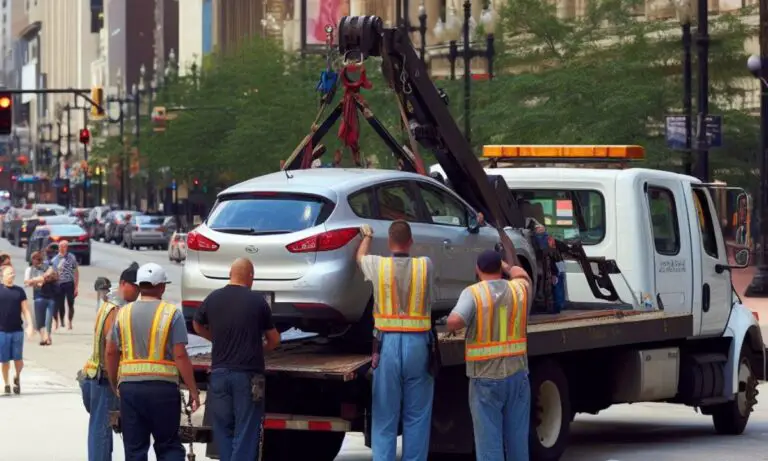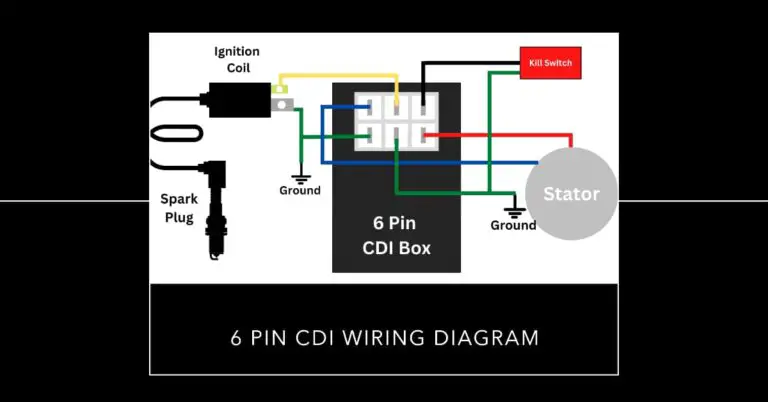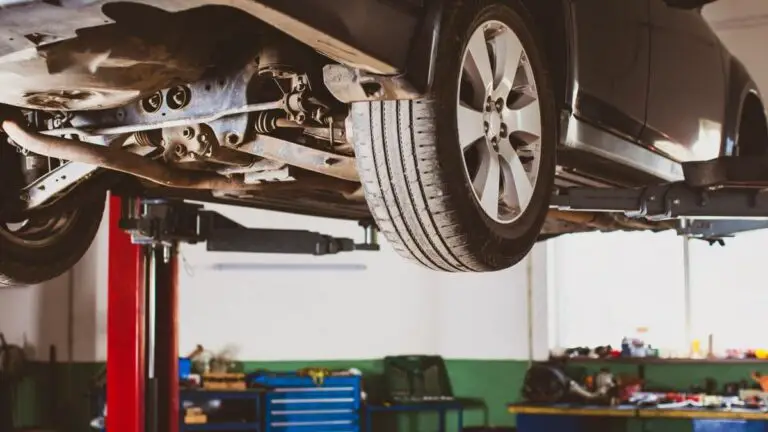7 Pin Trailer Wiring Diagram Explained

So you just got a new trailer and are getting ready to hook it up to your vehicle. You go to connect the wiring harness and notice it has a 7 pin connector instead of the standard 4 pin. How do you know what each of those wires does and where it needs to be connected?
The key is understanding how to read a 7 pin trailer wiring diagram. This guide will explain the purpose of each pin and wire, how to decipher wiring diagrams, troubleshoot issues, and answer other common questions about 7 pin trailer wiring.
By the end of this article, you’ll be able to confidently connect and repair a 7 pin trailer connector.
Table of Contents
what is 7 Pin Trailer Wiring Diagram?
A 7 pin trailer wiring diagram is a schematic that shows the pinout and function of each wire in a 7-way round trailer connector.
The standard 7-pin connector contains the following wires and functions:
- Pin 1 – Left Turn/Stop Signal (Green)
- Pin 2 – Ground (White)
- Pin 3 – Right Turn/Stop Signal (Yellow)
- Pin 4 – Auxiliary Power (Red)
- Pin 5 – Reverse Lights (Blue)
- Pin 6 – Brake Lights (Red)
- Pin 7 – Running Lights (Brown)
The diagram uses color coding and labeling to identify the purpose of each pin’s wire. It traces the path of the wires from the connector pins to their corresponding connections on the trailer lights and brakes.
7 pin diagrams provide a handy reference for wiring a trailer connector and troubleshooting any issues. They ensure each wire is connected to the proper pin for that circuit. Typical trailer wiring in the US adheres closely to the standard 7 pin functions, so diagrams are largely consistent.
Reading and understanding a 7 pin trailer wiring diagram is an essential skill for installing and maintaining trailer electrical systems. With the color coding and diagrams, you can confidently wire up or diagnose any 7-way round trailer plug.
So, let’s explain all this in details:
Pin Layout and Functions
The 7 pin connector standardized for most trailers in the US includes these pins and functions:
Pin 1 – Left Turn/Stop Signal (Green Wire)
The green wire provides power for the left turn signal and brake lights on the trailer. This wire is powered when the left turn signal or brake pedal is activated.
Pin 2 – Ground (White Wire)
The white wire connects to the trailer frame and chassis to provide a ground for the entire wiring system. Proper grounding prevents voltage leaks and ensures the lights operate at maximum brightness.
Pin 3 – Right Turn/Stop Signal (Yellow Wire)
The yellow wire carries power for the right turn signal and brake lights. It activates when the right turn signal or brake pedal is on.
Pin 4 – Auxiliary Power (Red Wire)
The auxiliary power pin connects to the vehicle’s 12V DC battery to provide a constant power source for the trailer. It may be used to charge the breakaway battery or power accessories.
Pin 5 – Reverse Lights (Blue Wire)
On trailers with reverse lights, the blue wire feeds power to activate them when the vehicle is shifted into reverse gear.
Pin 6 – Brake Lights (Red Wire)
Independent of the left and right brake lights, this red wire energizes the trailer brake lights.
Pin 7 – Running Lights (Brown Wire)
The brown wire provides power to the tail lights, side marker lights, and clearance lights on the trailer. It activates when the headlights turn on.
How to Read 7 Way Trailer Wiring Diagrams?
Interpreting trailer wiring diagrams is key for successfully installing and troubleshooting trailer connectors. Here’s how to read them:
- Wiring diagrams use specific colors and codes to identify wires, their functions, and connections.
- The ground wire is typically white, while the hot lead for each function is color coded by its purpose according to common conventions.
- Left turn/brake lights are green, right turn/brake lights are yellow, brake lights are red, etc.
- Diagrams are laid out to trace the path of each wire from end to end. They depict how wires connect to receptacles, lights, and between vehicle and trailer.
- Technical diagrams will show the color codes, voltage, wiring standards, and other specs needed to get the job done.
Here is an example of a basic 7 pin trailer wiring diagram:
[Image with labeled 7 pin trailer wiring diagram]
As you can see, the color coded wires leading from each pin on the connector plug are traced to their corresponding connections on the trailer lights.
Following diagrams like this makes it easy to troubleshoot or verify you have wired things up properly.
How to Wire a 7 Pin Trailer Connector?
Now let’s get into the specifics of how to wire a 7 pin plug from scratch:
Step 1: Gather the Proper Tools and Supplies
You’ll need:
- Wire crimping and stripping tools
- Variety pack of terminal butt connectors
- 7 pin connector plug
- Length of trailer wiring with 7 conductors
- Electrical tape
- Wire tester/multimeter
Step 2: Run the Wires to the Trailer
- Pull wires from the trailer side to where the 7 pin plug will mount on the vehicle, leaving a few extra feet for slack.
- Most installs use a combination of 16 or 14 gauge primary wire for lighting functions and a thicker 12 gauge wire for the auxiliary and brake functions. The ground wire is also typically 12 gauge.
Step 3: Match Up and Connect Wires
- Based on the wiring diagram for your specific trailer, match up each wire coming from the trailer side to the corresponding pin on the 7 pin plug.
- Strip 1/2 inch of insulation from each wire going into the plug using wire strippers.
- Crimp terminals onto the exposed ends and insert into the back side of the plug, securing each one to the matching pin. Tug wires to verify tightness.
Step 4: Ground the White Wire
- Locate a clean, rust-free spot on the trailer frame near the 7 pin socket.
- Strip 1/2 inch of insulation from the white ground wire leading from the plug.
- Secure the exposed end to the frame using a ring terminal and mounting bolt to ground it.
Step 5: Heat Shrink and Test Connections
- Seal wire connections by sliding heat shrink tubing over them and heating with a hair dryer or heat gun to tighten.
- Use a circuit tester to verify wiring connections from each pin on the plug to the corresponding trailer lights and components.
And that’s it – you now have a fully functioning 7 pin trailer wiring setup!
Troubleshooting Common 7 Pin Trailer Wiring Issues
Despite the best efforts, trailer wiring problems can and do happen. Here are some of the most common and how to diagnose them:
Problem: None of the Trailer Lights Work
Potential Causes:
- Bad ground connection
- Burnt out ground wire
- Faulty connector plug
- Loose, corroded, or damaged wiring
Solutions:
- Reattach ground wire securely to bare metal frame
- Test for continuity on ground wire and replace if broken
- Check plug for loose/corroded pins and fit on receptacle
- Inspect wires for damage and rewire as needed
Problem: Lights Work Intermittently or Are Dim
Potential Causes:
- Poor ground connection
- Damaged wires
- Exposed/Corroded connections
Solutions:
- Clean and tighten ground to frame
- Seal any pinholes/exposed copper in wires
- Cover connections to prevent corrosion
Problem: Brake Lights Not Working
Potential Causes:
- Bad connection at pin 6
- Faulty ground
- Burnt out bulb
- Issues with brake controller
Solutions:
- Check for power at pin 6 plug when brakes applied
- Confirm proper grounding at white wire
- Test/replace bulbs
- Adjust brake controller settings
Problem: Auxiliary Power Not Charging
Potential Causes:
- Blown fuse
- Loose/damaged connections
- Pin 4 wiring issues
Solutions:
- Check/replace fuse for auxiliary circuit
- Reconnect any loose plugs
- Test pin 4 wire for continuity/damage
In many cases, trailer wiring problems come down to bad connections or grounding. Carefully inspecting connectors and wires can reveal the source of electrical faults.
Frequently Asked Questions about 7 Pin Wiring
Let’s wrap up with answers to some other common questions about 7 pin trailer wiring:
What gauge wire should be used?
16 or 14 gauge wire works for lighting and power circuits. Use 12 gauge for brake and ground wires to handle the higher amp draw.
Where does the white ground wire get attached?
Attach the ground wire directly to the trailer frame using a ring terminal secured with a mounting bolt. Scrape any paint/grease from the spot for best contact.
My trailer lights work but the brakes don’t – why?
This points to an issue specific to the brake wiring – check the connection at the brake pin. Make sure your trailer brake controller is adjusted properly. Test the draw at the brake pin.
How do I convert a 4 pin plug to a 7 pin?
You’ll need to install a converter that essentially piggybacks into your existing 4-way. Most offer plug and play installation but you may need to run additional wires.
Can I splice into my truck’s wiring?
Splicing into existing wiring is not recommended – it’s best to run a dedicated harness from the truck to trailer plug. Converters are OK but splicing can cause voltage and overload issues.
How do I remember which pin is which?
Mnemonic tricks like “Brown is the New Black” (running lights) or memorizing the order right turn, left turn, brakes helps. Diagramming it out also provides a handy visual reference.
In Summary
Whether you’re installing new trailer wiring or troubleshooting existing connections, knowing how to work with 7 pin connectors is an invaluable skill. Hopefully this guide provided a helpful overview of:
- The purpose of each 7 pin wire and trailer light
- How to decipher 7 pin wiring diagrams
- Step-by-step installation of a 7 way plug
- Troubleshooting advice for common issues
- Answers to frequently asked questions
Properly understanding trailer wiring diagrams and connecting everything correctly goes a long way in getting your lights, turn signals, brakes, and power working properly.
Trailer wiring can seem complex, but just take it one step and one light at a time. Before you know it, you’ll be hooking up trailers with confidence. Safe travels!







